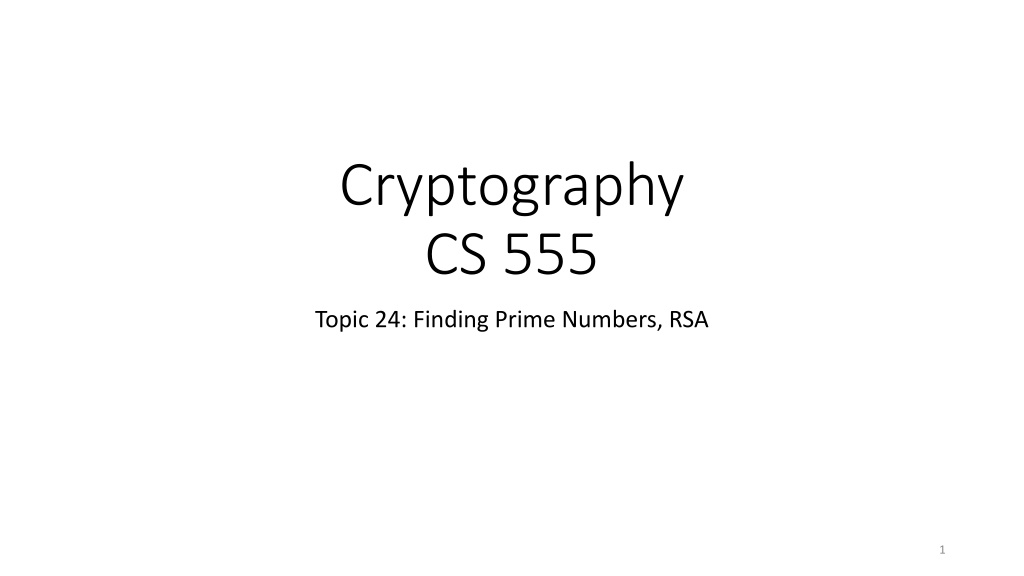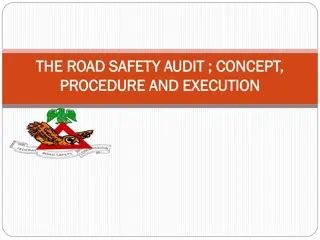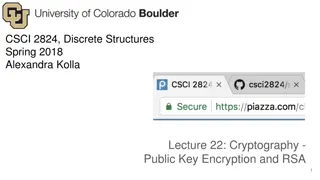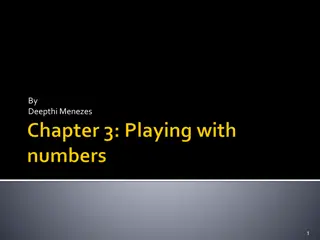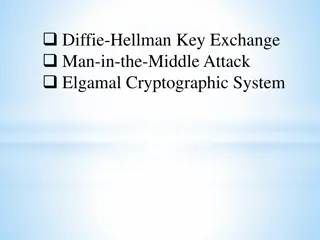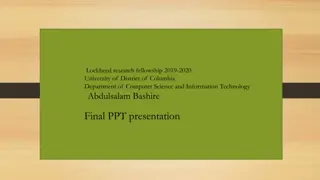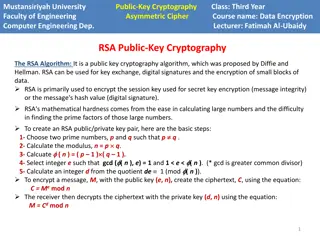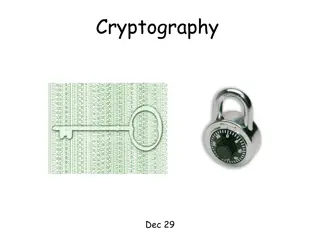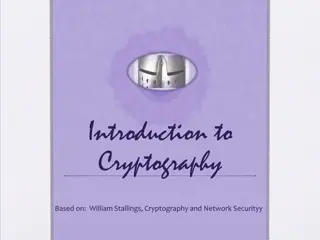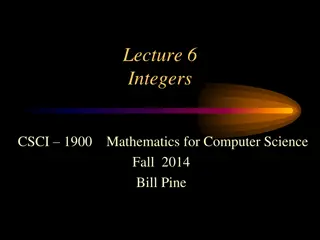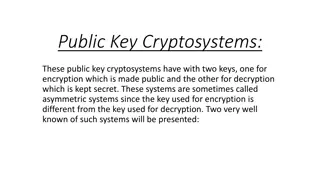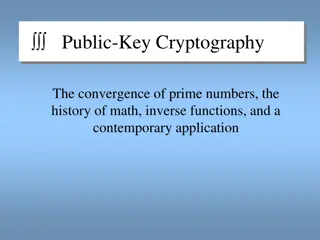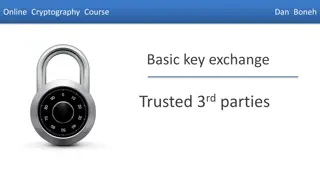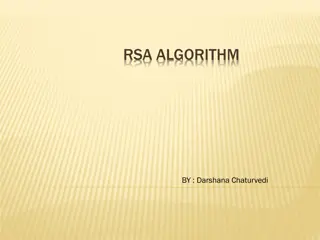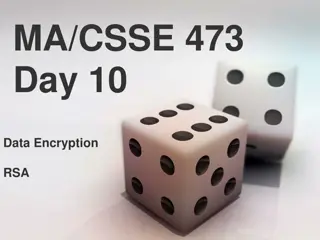Understanding Prime Numbers and RSA Algorithm in Cryptography
Delve into the world of prime numbers and the RSA algorithm in cryptography. Learn about key generation, Bertrand's Postulate, the Miller-Rabin test for primality, and the Almost Miller-Rabin test. Discover how these concepts are crucial in ensuring secure communication and data encryption.
Download Presentation

Please find below an Image/Link to download the presentation.
The content on the website is provided AS IS for your information and personal use only. It may not be sold, licensed, or shared on other websites without obtaining consent from the author. Download presentation by click this link. If you encounter any issues during the download, it is possible that the publisher has removed the file from their server.
E N D
Presentation Transcript
Cryptography CS 555 Topic 24: Finding Prime Numbers, RSA 1
Recap Number Theory Basics Abelian Groups ? ?? = ? 1 ? 1 for distinct primes p and q ? ? = N ??mod N = ?[? ??? ? ? ]mod N 2
RSA Key-Generation KeyGeneration(1n) Step 1: Pick two random n-bit primes p and q Step 2: Let N=pq, ? ? = (? 1)(? 1) Step 3: Question: How do we accomplish step one? 3
Bertrands Postulate Theorem 8.32. For any n > 1 the fraction of n-bit integers that are prime is at least 3?. 1 GenerateRandomPrime(1n) For i=1 to 3n2: p {0,1}n-1 p 1 ? if isPrime(p) then return p return fail Can we do this in polynomial time? 4
Bertrands Postulate Theorem 8.32. For any n > 1 the fraction of n-bit integers that are prime is at least 1 3?. Assume for now that we can run isPrime(p). What are the odds that the algorithm fails? GenerateRandomPrime(1n) For i=1 to 3n2: p {0,1}n-1 p 1 ? if isPrime(p) then return p return fail On each iteration the probability that p is not a prime is 1 3? 1 We fail if we pick a non-prime in all 3n2 iterations. The probability is ? 3?2 3? 1 1 ? ? 1 = 1 3? 3? 5
isPrime(p): Miller-Rabin Test We can check for primality of p in polynomial time in ? . Theory: Deterministic algorithm to test for primality. See breakthrough paper Primes is in P Practice: Miller-Rabin Test (randomized algorithm) Guarantee 1: If p is prime then the test outputs YES Guarantee 2: If p is not prime then the test outputs NO except with negligible probability. https://www.cse.iitk.ac.in/users/manindra/algebra/primality_v6.pdf 6
The Almost Miller-Rabin Test Input: Integer N and parameter 1t Output: prime or composite for i=1 to t: a {1, ,N-1} if ?? 1 mod Nthen return composite Return prime Claim: If N is prime then algorithm always outputs prime Proof: For any a {1, ,N 1} we have?? 1= ?? ?= 1 ??? ? 7
The Almost Miller-Rabin Test Need a bit of extra work to handle Carmichael numbers. Input: Integer N and parameter 1t Output: prime or composite for i=1 to t: a {1, ,N-1} if ?? 1 1 mod Nthen return composite Return prime Fact: If N is composite and not a Carmichael number then the algorithm outputs composite with probability 1 2 ? 8
Back to RSA Key-Generation KeyGeneration(1n) Step 1: Pick two random n-bit primes p and q Step 2: Let N=pq, ? ? = (? 1)(? 1) Step 3: Pick e > 1 such that gcd(e, ? ? )=1 Step 4: Set d=[e-1 mod ? ? ] (secret key) Return: N, e, d How do we find d? Answer: Use extended gcd algorithm to find e-1mod ? ? . 9
(Plain) RSA Encryption Public Key: PK=(N,e) Message m N EncPK(m) = ??modN Remark: Encryption is efficient if we use the power mod algorithm. 10
(Plain) RSA Decryption Public Key: SK=(N,d) Ciphertext c N D De ecSK(c) = ??modN Remark 1: Decryption is efficient if we use the power mod algorithm. Remark 2: Suppose that m N and let c=EncPK(m) = ??modN ?? ?modN = ???modN = ?[?? ??? ? ? ]modN = ?1modN = ? De DecSK(c) = 11
RSA Decryption Public Key: SK=(N,d) Ciphertext c N D De ecSK(c) = ??modN Remark 1: Decryption is efficient if we use the power mod algorithm. Remark 2: Suppose that m N De DecSK(c) = ? Remark 3: Even if m N De DecSK(c) = ? Use Chinese Remainder Theorem to show this and let c=EncPK(m) = ??modN then and let c=EncPK(m) = ??modN then N 12
Factoring Assumption Let GenModulus(1n) be a randomized algorithm that outputs (N=pq,p,q) where p and q are n-bit primes (except with negligible probability negl(n)). Experiment FACTORA,n 1. (N=pq,p,q) GenModulus(1n) 2. Attacker A is given N as input 3. Attacker A outputs p > 1 and q > 1 4. Attacker A wins if N=p q . 13
Factoring Assumption Necessary for security of RSA. Not known to be sufficient. Experiment FACTORA,n 1. (N=pq,p,q) GenModulus(1n) 2. Attacker A is given N as input 3. Attacker A outputs p > 1 and q > 1 4. Attacker A wins (FACTORA,n= 1) if and only if N=p q . ??? ? ? (negligible) s.t Pr FACTORA,n= 1 ?(?) 14
RSA-Assumption RSA-Experiment: RSA-INVA,n 1. Run KeyGeneration(1n) to obtain (N,e,d) 2. Pick uniform y 3. Attacker A is given N, e, y and outputs x 4. Attacker wins (RSA-INVA,n=1) if ??= y mod N N N ??? ? ? (negligible) s.t Pr RSA INVA,n = 1 ?(?) 15
(Plain) RSA Discussion We have not introduced security models like CPA-Security or CCA-security for Public Key Cryptosystems However, notice that (Plain) RSA Encryption is stateless and deterministic. Plain RSA is not secure against chosen-plaintext attacks Plain RSA is also highly vulnerable to chosen-ciphertext attacks Attacker intercepts ciphertext c of secret message m Attacker generates ciphertext c for secret message 2m Attacker asks for decryption of c to obtain 2m Divide by 2 to recover original message m 16
(Plain) RSA Discussion However, notice that (Plain) RSA Encryption is stateless and deterministic. Plain RSA is not secure against chosen-plaintext attacks In a public key setting the attacker does have access to an encryption oracle Encrypted messages with low entropy are vulnerable to a brute-force attack 17
(Plain) RSA Discussion Plain RSA is also highly vulnerable to chosen-ciphertext attacks Attacker intercepts ciphertext ? = ??modN Attacker asks for decryption of ?2?modN and receives 2m. Divide by two to recover message As above example shows plain RSA is also highly vulnerable to ciphertext-tampering attacks See homework questions 18
Mathematica Demo https://www.cs.purdue.edu/homes/jblocki/courses/555_Spring17/slid es/Lecture24Demo.nb Note: Online version of mathematica available at https://sandbox.open.wolframcloud.com (reduced functionality, but can be used to solve homework bonus problems) 19
Next Class Read Katz and Lindell 8.3, 11.5.1 Discrete Log, DDH + Attacks on Plain RSA 20
